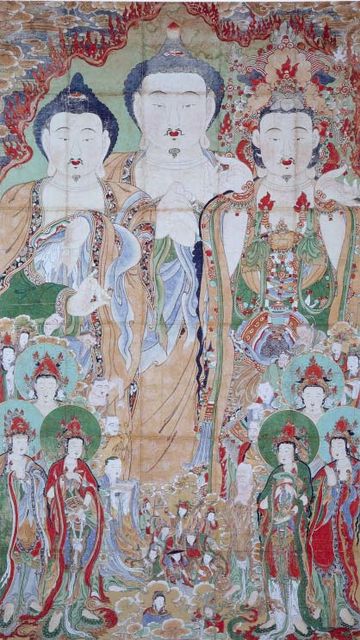남양주 봉선사 비로자나삼신괘불도
| 남양주 봉선사 비로자나삼신괘불도 Hanging Painting of Bongseonsa Temple, Namyangju (Vairocana Buddha Triad) |
|
 남양주 봉선사 비로자나삼신괘불도, 국가문화유산포털, 문화재청. |
|
| 대표명칭 | 남양주 봉선사 비로자나삼신괘불도 |
|---|---|
| 영문명칭 | Hanging Painting of Bongseonsa Temple, Namyangju (Vairocana Buddha Triad) |
| 한자 | 南楊州 奉先寺 毘盧遮那三身掛佛圖 |
| 주소 | 경기도 남양주시 진접읍 봉선사길 32 |
| 지정(등록) 종목 | 보물 제1792호 |
| 지정(등록)일 | 2012년 12월 27일 |
| 분류 | 유물/불교회화/괘불화/삼신불도 |
| 시대 | 조선시대 |
| 수량/면적 | 1폭 |
| 웹사이트 | 남양주 봉선사 비로자나삼신괘불도, 국가문화유산포털, 문화재청. |
|
|
|
해설문
국문
괘불은 절이나 큰 법회에서 불교 의식을 행할 때 그림으로 그려서 법당 앞뜰에 걸어 놓은 부처의 모습을 말한다. 남양주 봉선사 비로자나 삼신 괘불도는 조선 영조 11년(1759) 상궁 이성애가 숙종의 후궁인 영빈 김씨(寧嬪 金氏, 1669~1735)의 명복을 빌며 제작한 불화이다. 이 불화는 가로 95cm, 세로 144cm의 종이를 각각 가로 폭 5매, 세로 폭 6매씩 총 30매를 이어 붙여 제작하였다.
비로자나 삼신 괘불도는 크게 상하 2단 구도로 나누어져 있다. 그림 위쪽 가운데에는 법신(法身) 비로자나불이, 오른쪽에는 보신(報身) 노사나불이, 왼쪽에는 화신(化身) 석가모니불이 배치되어 있다. 그림 아래에는 6보살과 제석, 범천, 10대 제자, 천인, 설법을 경청하는 대중들을 ‘브이(V)’자 모양으로 배치하였으며, 그림 아래 가운데에는 각종 악기를 연주하고 있는 천인과 설법을 경청하는 인물을 구름으로 구획하여 배치하였다.
남양주 봉선사 비로자나 삼신 괘불도는 밝고 화사한 색과 굵고 힘찬 묵선이 조화를 이루어 인물들의 생동감 있는 움직임과 자연스러운 옷자락 주름을 수준 높게 표현하고 있다. 전체적으로 보면 삼신불과 권속들이 함께 그려져 있지만 언뜻 보면 삼신불 중심의 구도로 보일 만큼 삼신불이 화면 윗부분에 큼직하게 배치되어 있는데, 이러한 구도는 18세기 중후반경에 제작된 서울과 경기 지역의 삼신불 괘불도에서 흔히 볼 수 있다.
영문
Hanging Painting of Bongseonsa Temple, Namyangju (Vairocana Buddha Triad)
Hanging banner paintings were displayed outdoors on special occasions such as the Buddha’s birthday, outdoor rites, and the funerals of eminent monks.
This banner painting of Bongseonsa Temple was created in 1759 under the commission of a court lady named Yi Seong-ae praying for the peace of the spirit of Lady Kim (1669-1735), one of the royal concubines of King Sukjong (r. 1674-1720) of the Joseon dynasty (1392-1910). The painting was created on a large canvas made by sewing a total of 30 pieces of 95x144 cm paper in a 5 by 6 grid.
The upper part of the painting consists of Vairocana (the Cosmic Buddha) in the center with Sakyamuni Buddha and Rocana Buddha to the left and right, respectively. These three buddhas represent the three distinct bodies or aspects of a buddha, known together as Trikaya. Vairocana represents the “truth body (Dharmakaya),” i.e. the absolute universal knowledge, Rocana represents the “enjoyment body (Sambhogakaya),” i.e. the enlightenment achieved through meditative practice, and Sakyamuni represents the “emanation body (Nirmanakaya),” i.e. the human-like body a buddha manifests on Earth in order to teach humankind.
The lower part of the painting features six bodhisattvas, Indra, Brahma, and ten disciples depicted to the sides. At the bottom center of the painting is a group of celestial musicians and the audience of the buddhas’ sermon surrounded by auspicious clouds.
The painting is marked by its harmony of bright, clear colors with thick, energetic brushstrokes by which the movements and robes of the buddhas and their followers are elaborately depicted. Although the painting presents both the Trikaya triad and their retinue and worshippers, the three buddhas dominate almost the entire painting, clearly showing that it is dedicated to the triad. The composition displays the characteristic features of ceremonial banner paintings of Trikaya triads produced in the capital area in the mid- to late 18th century.
영문 해설 내용
괘불은 사찰에서 큰 법회나 의식을 행할 때 야외에 걸어놓고 예배를 드리는 데 쓰였다.
봉선사의 괘불은 1759년 상궁 이성애가 숙종(재위 1674-1720)의 후궁인 영빈 김씨(1669-1735)의 명복을 빌기 위해 제작하였다. 가로 95cm, 세로 144cm의 종이를 각각 가로 5매, 세로 6매씩 총 30매를 이어 붙여 제작하였다.
이 그림은 크게 상하 2단 구도로 나누어져 있다. 위쪽에는 비로자나불을 중심으로 왼쪽과 오른쪽에 각각 석가모니불과 노사나불을 배치하였다. 세 불상은 각각 부처의 세 가지 몸 또는 유형을 가리키는 ‘삼신’을 나타낸다. 비로자나불은 진리 그 자체를 나타내는 ‘법신’이고, 노사나불은 수행을 통해 깨달음을 성취한 ‘보신’이며, 석가모니불은 중생을 교화하기 위해 중생과 같은 몸으로 나타나는 ’화신‘을 나타낸다.
아래쪽에는 6보살, 제석, 범천, 10대 제자 등을 양옆에 배치하였고, 가운데에는 각종 악기를 연주하고 있는 천인과 설법을 경청하는 인물을 구름으로 구획하여 배치하였다.
밝고 화사한 색과 굵고 힘찬 묵선이 조화를 이루어 인물들의 생동감 있는 움직임과 자연스러운 옷자락 주름을 수준 높게 표현하고 있다. 전체적으로 보면 삼신불과 권속들이 함께 그려져 있지만 언뜻 보면 삼신불 중심의 구도로 보일 만큼 삼신불이 화면 윗부분에 큼직하게 배치되어 있는데, 이러한 구도는 18세기 중후반경에 제작된 서울과 경기 지역의 삼신불 괘불도에서 흔히 볼 수 있다.